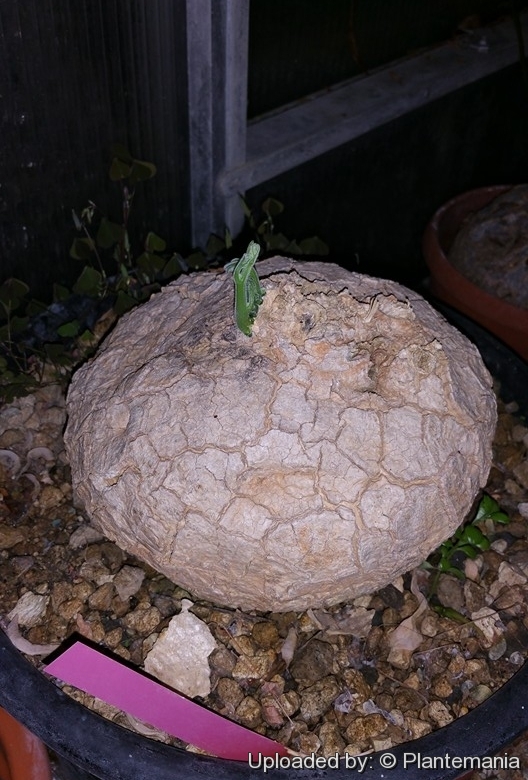




Your support is critical to our success.
- Encyclopedia of SUCCULENTS
- Encyclopedia Index
- Families
- Genera
- Species
- Cucurbitaceae
- Ampelosicyos
- Caudiciforms
Since 4 Aug 2013
Taxon 60(1): 133. 2011 [10 Feb 2011]
Family: CUCURBITACEAE

Origin and Habitat: SW Madagascar.
Synonyms:
- Ampelosicyos bosseri (Keraudren) H.Schaef. & S.S.Renner
- Odosicyos bosseri Keraudren
Description: Ampelosicyos bosseriSN|33644]]SN|33644]] (syn: Odosicyos bosseriSN|33645]]SN|33645]]) is a perennial dioecious climbers with large flattened or round tuberous rootstock. It differs significantly from all other species encountered in the same southern zone of Madagascar. The tendrils are simple. The leaves are rather long petioled, densely pubescent, with 3 to 5 lobes more or less wide, sometimes very narrow (25 mm), with large triangular teeth on the margin. The large cucumber-like fruit, is very fleshy, smooth with scarcely marked ribs. The seeds are quite special, asymmetrical of large dimensions (up to 25 mm) and very thick (10 mm). It is very difficult to identify caudiform Cucurbitaceae only by tuber and leaves in the absence of flowers and fruits.
Derivation of specific name: "bosseri" For Jean M. Bosser, French botanist and agronomical engineer, and director of ORSTOM (Office de la recherche scientifique et technique outre-mer) in Antananarivo, Madagascar.
Caudex: More or less voluminous, mostly 30-60 cm in diameter (occasionally 1-2 metres across), subterranean or half-buried. The young tubers have a long, elongate, branched tap root.
Stems (vines): Slender, herbaceous, 5-ribbed longitudinally, hairy, usually 1-2 m or longer (to 4-6 metres), 10-15 mm in diameter at base, erect to twining to the surrounding vegetation, branched, probably annual. Often only one is born from the smallest tubers. Tendrils present, simple, long.
Leaves: Dimorphic. Petiolate, (3-)5-lobed, large, 10-15cm long, 10cm wide, base cordate-truncate, margins with angled-triangular teeth, lower face with long hairs, veins prominent below. petiole 3-15 cm long.
Inflorescences: Elongate racemes, with several flowers.
Male flowers: Long-stalked. Sepals shortly triangular.Petals 5, united at base, spreading, 10 mm long, 5 mm wide, white to cream, veins darker, tips divided into numerous long, often curved threads. Tube short, about 1cm long. Stamens 3.
Fruits: Obovate, cucumber-like, with subacute tip, 10-15 cm long, 5-8 cm in diameter, indehiscent, very fleshy, but with a fibrous pulp, smooth, with scarcely marked ribs.
Seeds: Many up to 25 mm long, very thick (10 mm), asymmetrical, the side of the hilum almost always rectilinear, the opposite side rounded.
Bibliography: Major references and further lectures
1) Urs Eggli "Illustrated Handbook of Succulent Plants: Dicotyledons" Springer Science & Business Media, 2002
2) Werner Rauh, Herman Schwartz "Succulent and xerophytic plants of Madagascar", Volume 2 Strawberry Press, 1998
3) Monique Keraudren-Aymonin (1982) "Odosicyos bosseri, Cucurbitacée
4) énigmatique du Sud-ouest de Madagascar", Bulletin de la Société Botanique de France. Lettres Botaniques, 129:2, 149-154, http://dx.doi.org/10.1080/01811797.1982.10824538
5) Hanno Schaefer & Susanne S. Renner "Phylogenetic relationships in the order Cucurbitales and a new classification of the gourd family (Cucurbitaceae)" TAXON 60 (1) - February 2011: 122–138, http://www.umsl.edu/~renners/Schaefer&Renner_Cucs_Taxon2011.pdf
6) Urs Eggli, Leonard E. Newton: “Etymological Dictionary of Succulent Plant Names” Springer, Berlin/Heidelberg 2010
Cultivation and Propagation: This plant can take a good deal of water during active growth, and should be watered only when not dormant. Keep dryish in winter. This plant should be over-wintered in the greenhouse at temperatures over 12°C (avoid letting temperatures drop lower than 5° C). Use a very draining but rich soil, and not too much sun. Errors in cultivation may produce unsightly holes in the tuber.
Reproduction: Can be reproduced both by cuttings and seeds. Cuttings don't normally grow caudexes (but sometimes do!)
| Your Actions | |
|---|---|
| Back to Ampelosicyos index | |
| Back to Cucurbitaceae index | |
 |
Back to Succulents Encyclopedia index |
Privacy stantement - Terms and conditions - How to cite - About us - Feedback - Donate



